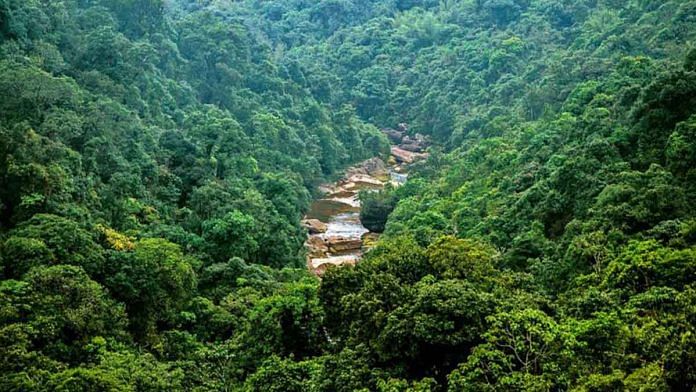New Delhi: A Supreme Court (SC) bench headed by Chief Justice D.Y. Chandrachud Monday issued an interim order in a case against the Forest (Conservation) Amendment Act (FCA) passed in 2023. It stated that the Union government must use the “dictionary definition” of forests in the process of identifying forest land in all states. The court also said that any construction of zoos or wildlife safaris in forest areas, a measure allowed by the amendment, will require prior approval from SC.
The order brings temporary relief against the measures of the Forest (Conservation) Amendment Act, which environmentalists allege reduces the protection offered to forest land in India by narrowing the definition of forests to only classified forests.
Without protection, unclassified forest lands can be diverted for non-forest use and commercial purposes without any prior approval needed. The court Monday upheld the TN Godavarman ruling of 1996 to say that any land that fits the dictionary definition of forests is to be identified and protected by the government.
It was in response to writ petitions filed by several groups, including retired Indian Forest Service (IFS) officials led by Ashok Kumar Sharma, the NGO Vanashakti, Bangalore Environment Trust, and Swachh Nagpur which all challenge the constitutional validity of the FCA 2023.
“The simple thing is that the Forest (Conservation) Amendment Act has done away with the dictionary definition of forests in the country. The Supreme Court has now restored their status as an interim measure,” said Ritwick Dutta, an environmental lawyer.
Passed in July 2023, the FCA brought about major changes to the definition of forests in the country. In Section 1, it says that only those lands that have been notified or recorded as forests in the Indian Forest Act, or any government records after 1980 will be granted protection under this Act. This was protested against by politicians such as Congress MP Jairam Ramesh in Parliament and groups such as Mulniwasi Samajsevak Sangh and Adivasi Samanvay Samiti Bharat, when it was first implemented.
Also read: India experimented with tree plantation for 200 yrs. Foresters must learn from past mistakes
What does SC’s interim order imply?
Under the FCA 2023, 15 percent of India’s total forest cover — or 1.99 lakh sq km of area deemed as forests but not officially recorded anywhere — was effectively excluded.
The SC’s order is an interim measure, asking states to revert to the original definition of forests when carrying out identifying and recording all forest land in their region. This original definition was a clause included by the SC itself, in a 1996 order called the TN Godavarman ruling. The Godavarman ruling said that the Forest Conservation Act, 1980, was enacted to conserve forests and applied to all forests, regardless of whether they are classified as such.
Tushar Dash, an independent researcher working on forest rights and governance in Odisha, said that this FC Amendment Act was expected to get into litigation. “All the concerns raised by the Supreme Court now were raised months ago by Adivasi groups, environmentalists, and forest rights activists when the Forest Conservation Amendment Bill was first brought up,” said Dash.
“The Amendment basically dilutes the original intention of the Forest Conservation Act of 1980 which was to conserve forests,” he added. “It also comes in conflict with the Forest Rights Act (FRA) of 2006 — how can the amendment exempt a number of projects from forest clearance when the rights for taking decision on forest land use rests with gram sabhas as defined in the FRA?”
However, the SC bench Monday said, “Pending the completion of exercise by the administration of the State Governments and Union territories, under Rule 16, the principles which are elucidated in the judgment of this court in TN Godavarman must be continued to be observed.”
Rule 16 of the Forest Conservation Rules, which came into effect on 1 December, 2023, said that all states and Union territories must identify and prepare a record of all forest lands within one year of the notification of the FCA 2023.
The court’s decision clarifies that for preparing this record of forest land, all states should use the TN Godavarman ruling’s definition of forests, which includes forest land that is not just classified or recorded as forests but also any forest land that falls under the dictionary definition of forests.
“Dictionary definition forests can still be diverted for non-forest purposes. It is just that earlier they weren’t even defined as forests, but now that they’re defined, prior permission of the Central government will be needed to restore them,” says Dutta.
The SC also asked all states and UTs to provide the record of forest land by 31 March, two weeks after the order. These records will then be digitised and made public by the Ministry of Environment, Forests and Climate Change by 15 April.
“Although interim, this is a big win because the court has indicated that TN Godavarman ruling’s definition of forests, which seems to be wider and more inclusive, ought to be adhered to, at least until the final hearing of the case in July,” said Anindita Mitra, advocate-on-record of the Supreme Court of India, who was present at the hearing.
Also read: ‘Death knell’ for India’s forests — experts submit objections to JPC on changes to forest law
What about zoos and safaris?
Another aspect of the FCA 2023 that was considered controversial was Section 5, which defines the construction of zoos and wildlife safaris in forest land as work that is “relating to or ancillary to conservation”. Therefore, the amendment allows for zoos and safaris to come up in forest land other than protected areas without any prior permission required.
The petitioners, in their original document filed on 20 October, 2023, said that zoos and wildlife safaris are “merely enclosures for animals” and cannot be equated with conservation measures. “This is a blatant attempt to open floodgates to increased forest diversions, while ignoring the associated negative impacts on otherwise intact forests and wildlife,” read the petition.
In its order Monday, however, the SC Bench directed that any proposal to establish a zoo or safari in a forest area “shall not be finally approved save and except with the prior permission of this Court.”
The petitioners had cited the case of the planned jungle safari project in the Aravalli forest range in Haryana, which other environmentalists, too, have filed a case against, saying it will damage the ecosystem of the Aravallis.
“The construction of zoos and wildlife safaris in forest areas needed no clearance, according to the Amendment. But now the Supreme Court has changed that, adding an extra layer of protection so these areas aren’t diverted to become zoos or safaris at anyone’s whims,” said Dutta.
The Kuno National Park in Madhya Pradesh is planning to construct a cheetah enclosure and wildlife safari, as well as an interpretation centre, along the lines of Devalia at Gir National Park. The officials are currently not worried about the implications of the SC order on their plans. “We have an in-principle approval from the Central Zoo Authority for our safari and interpretation center,” said Uttam Kumar Sharma, Field Director of the Kuno National Park, to The Print.

The plans currently involve a 180-hectare area, 56 hectares of which is in revenue land while the rest is forest land.
“All our planned construction will take place in the revenue land, not in forest land. But if the Supreme Court says we need their approval for the project, we will apply for that too in due time,” Sharma added.
Final hearing on 19 July
The SC adjourned the final hearing of the case, which challenges the constitutional validity of the amendment, until 19 July. Now, the Union government has been directed to collect and publish the records of forests in all states by 15 April.
Given the interim nature of the relief, however, Dash warns against the future implications of the FCA 2023. “The act has just created long-standing confusion over what defines a forest. While state governments will now wrestle with this confusion, it will ultimately be forests and forest dwellers that will be affected by it,” said Dash.
(Edited by Zinnia Ray Chaudhuri)
Also read: New criminal laws, data protection to women’s reservation — 10 significant laws passed in 2023



